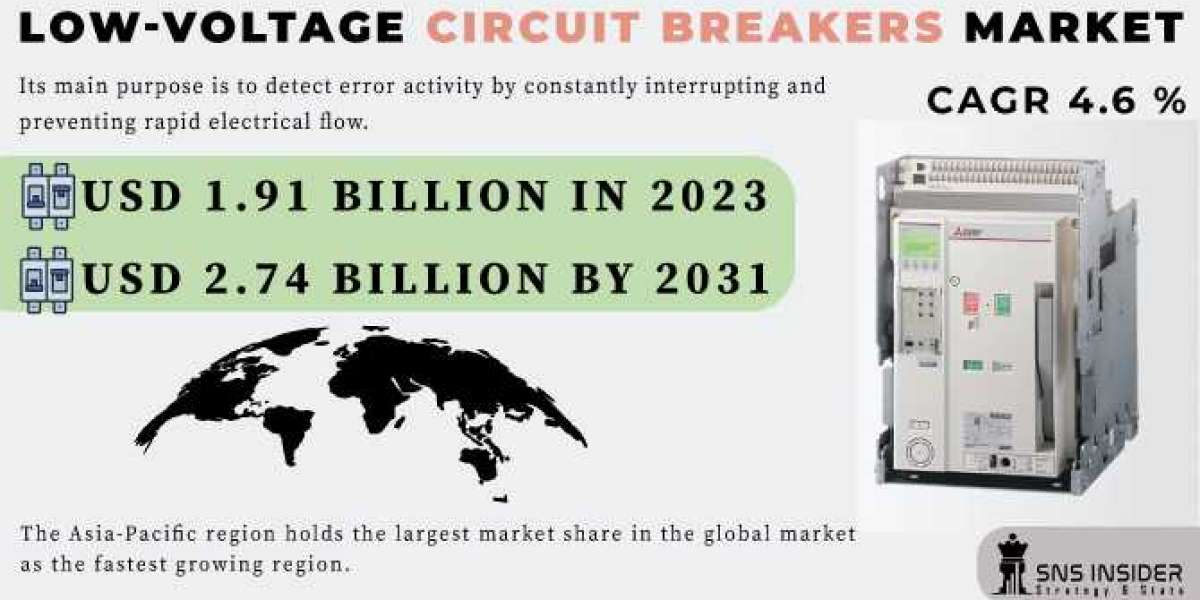Low-voltage circuit breakers are critical components in electrical systems, designed to protect circuits from overcurrent and short circuits by automatically interrupting the flow of electricity when necessary. These devices are essential for ensuring the safety and reliability of electrical systems in residential, commercial, and industrial applications. By preventing damage to electrical components and reducing the risk of electrical fires, low-voltage circuit breakers play a crucial role in maintaining the integrity of power distribution systems. Advances in technology and design continue to enhance the performance and capabilities of these breakers, making them increasingly effective in managing and protecting modern electrical infrastructure.
The Low-Voltage Circuit Breakers Market, valued at USD 1.91 billion in 2023, is projected to reach USD 2.74 billion by 2031, growing at a compound annual growth rate (CAGR) of 4.6% during the forecast period from 2024 to 2031.
Future Scope:
The future of low-voltage circuit breakers is marked by significant advancements driven by technological innovation and evolving industry requirements. As electrical systems become more complex and integrated, there will be a growing demand for circuit breakers that offer enhanced functionality, precision, and reliability. Innovations in materials and design will lead to more compact and efficient circuit breakers with improved performance characteristics. The integration of smart technologies, such as remote monitoring and digital control systems, will enable more sophisticated protection and management of electrical systems. Additionally, the emphasis on energy efficiency and sustainability will influence the development of low-voltage circuit breakers that minimize energy consumption and environmental impact.
Key Points:
- Protection and Safety:Low-voltage circuit breakers safeguard electrical systems from overcurrent and short circuits.
- Technological Advancements:Innovations in materials and design enhance the performance and compactness of circuit breakers.
- Smart Technologies:Integration of remote monitoring and digital controls provides advanced system management and protection.
- Energy Efficiency:Focus on reducing energy consumption and environmental impact drives development.
- Versatility:Suitable for a wide range of applications in residential, commercial, and industrial settings.
Trends:
Several key trends are shaping the development of low-voltage circuit breakers. One prominent trend is the integration of smart technologies, which allows for remote monitoring and control, as well as real-time data analysis to improve system management and reliability. Another trend is the move towards more compact and efficient designs, driven by the need for space-saving solutions in modern electrical systems. Advances in materials science are also contributing to the development of circuit breakers with enhanced performance characteristics and greater durability. Additionally, there is a growing emphasis on energy efficiency and sustainability, with a focus on reducing the environmental impact of electrical components while maintaining high levels of protection and reliability.
Application:
Low-voltage circuit breakers are used in a wide range of applications to ensure the safety and reliability of electrical systems. In residential settings, they protect household wiring and appliances from overcurrent and short circuits, contributing to overall home safety. In commercial buildings, low-voltage circuit breakers are used to safeguard electrical distribution systems and ensure uninterrupted power supply for critical operations. In industrial environments, they protect machinery and equipment from electrical faults, reducing the risk of damage and downtime. Additionally, low-voltage circuit breakers are essential for infrastructure projects, including data centers and transportation systems, where reliable power distribution and protection are crucial.
Conclusion:
Low-voltage circuit breakers are vital components in electrical systems, providing essential protection against overcurrent and short circuits. As technology continues to advance, these devices will see improvements in performance, functionality, and efficiency, driven by innovations in materials, smart technologies, and energy management. The versatility of low-voltage circuit breakers ensures their application across a broad spectrum of settings, from residential and commercial to industrial and infrastructure projects. By enhancing safety, reliability, and efficiency, low-voltage circuit breakers play a crucial role in maintaining the integrity of electrical systems and supporting the continued evolution of modern electrical infrastructure.
Read More Details: https://www.snsinsider.com/reports/low-voltage-circuit-breakers-market-1366
Contact Us:
Akash Anand – Head of Business Development Strategy
Phone: +1-415-230-0044 (US) | +91-7798602273 (IND)














